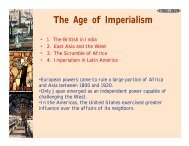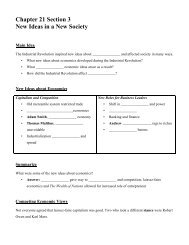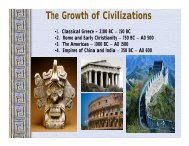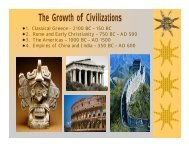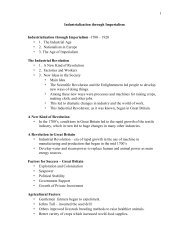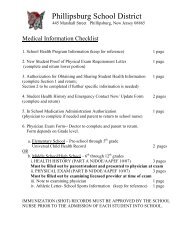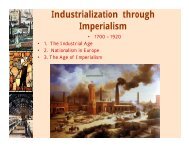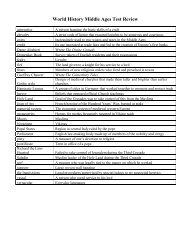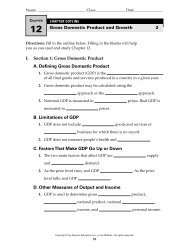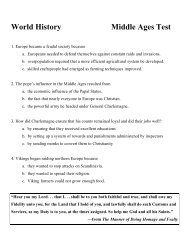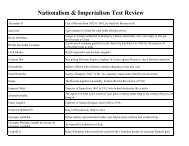You also want an ePaper? Increase the reach of your titles
YUMPU automatically turns print PDFs into web optimized ePapers that Google loves.
AIVIERJCAN HiSTORY FROM iSOLATION TO WORLD LEADERSHIP 569<br />
4. Describe two important results of <strong>World</strong> <strong>War</strong> I in each of the following areas:<br />
(a) social (b) economic (c) political.<br />
PART 6. The United States Is Torn Between<br />
Isolation and International Cooperation<br />
(1919—1939)<br />
OPPOSING VIEWPOINTS ON AMERICAN FOREIGN POLICY<br />
1. Isolation: The Predominant Sentiment<br />
a. Disillusionment With <strong>World</strong> <strong>War</strong> I. Many Americans were dlisap<br />
pointed with the results of the war. It had proved costly in American lives and<br />
money. Instead of making “the world safe for democracy,” it had led to major<br />
European dictatorships. Instead of being a “war to end all wars,” it had appar<br />
2ntly planted the seeds for another world conflict.<br />
b. American Tradition of Isolation. Isolationists claimed that, except<br />
or <strong>World</strong> <strong>War</strong> I, the United States had consistently and successfully pursued a<br />
policy of isolation. Now they demanded that the United States return to and<br />
tricdy adhere to its traditional policy.<br />
c. Peace Through Isolation. Isolationists argued that America could<br />
iave peace only by shutting itself off from the rest of the world. Let Uncle Sam<br />
“stay on his side of the street” while Europe “stews in its own juice.”<br />
Isolationist sentiment was powerful during the 1920s as well as during the<br />
iepression years, when Americans concentrated upon domestic problems. It<br />
found expression in books, plays, and newspapers, and it received strong support<br />
om a powerful group of Senators.<br />
2. International Cooperation: The Minority View<br />
a. Defense of <strong>World</strong> <strong>War</strong> I. Internationalists defended American en<br />
rance into <strong>World</strong> <strong>War</strong> I by emphasizing Wilsonian idealism and national security.<br />
fhey claimed that, by rejecting world leadership, the United States endangered<br />
ts own security and lost the opportunity to assure world peace.<br />
b. Failure ofIsolation. Opponents of isolation insisted that isolation had<br />
iot worked in the past, pointing to American involvement in the Napoleonic <strong>War</strong>s<br />
by the <strong>War</strong> of 1812) and <strong>World</strong> <strong>War</strong> I. Now that economic factors and.scientiflc<br />
rogress had brought nations even closer together, internationalists argued, iso<br />
ation was unrealistic.<br />
c. Peace Through International Cooperation. Internationalists ar<br />
sued that America could have peace only by cooperating with peace-loving na<br />
ions against aggression. We cannot “stop the world and get off.”<br />
Sentiment for cooperation grew in the late 1930s, as Americans observed<br />
Fascist militarism and aggression. President Franklin D. Roosevelt, who had<br />
served under and admired Wilson, worked cautiously but deliberately to swing<br />
public opinion away from isolation. However, not until Britain stood alone in<br />
<strong>World</strong> <strong>War</strong> II did international cooperation achieve acceptance by a majority of<br />
Americans.<br />
UNITED STATES REFUSAL TO JOIN THE LEAGUE OF NATIONS<br />
1. Brief Survey of the League of Nations<br />
a. Establishment. Woodrow Wilson believed that the single most im<br />
portant step toward world peace was the League of Nations. Wilson succeeded<br />
in placing the League Covenant (Charter) into the Treaty of Versailles.<br />
b. Pu,poses. By international cooperation, the League proposed to (1)<br />
deal with economic and social problems, (2) encourage disarmament, and (3)<br />
settle disputes among nations peacefully. If an aggressor nation refused to submit<br />
to peaceful settlement, the League could advise, but not force, its member na<br />
tions to employ coercive measures, called sanctions. These might be withdrawing<br />
ambassadors; halting trade; and, finally, using military force.<br />
2. Senate Defeat of the Treaty of Versailles and the League<br />
a. Republican Opposition. In control of the Senate, the Republicans<br />
consisted of (1) a small group of extreme isolationists, notably William Borah,<br />
Hiram Johnson, and Robert La Follette, and (2) a large group of more moderate<br />
Senators, most of whom supported the chairman of the Foreign Relations Com<br />
mittee, Henry Cabot Lodge, Sr. Bitterly hostile to Wilson, Senator Lodge deter<br />
mined to humiliate the President, to “republicanize” the Treaty of Versailles, and<br />
to protect American sovereignty by adding to the League Charter interpretations,<br />
called reseruations. Lodge held lengthy committee hearings to delay action and<br />
win support from the public and the Senate.<br />
b. Arguments Aguinst the League. Lodge and his supporters offered<br />
the following arguments: (1) The League might involve the United States in a<br />
war, thereby violating the American Constitution, which gives Congress the ex<br />
clusive power to declare war. (2) The League might interfere in domestic matters,<br />
such as tariff and immigration policies. (3) The League would be under the dis<br />
proportionate influence of Great Britain, since Britain and each of its dominions<br />
had a vote in the League Assembly. (4) League membership would involve us<br />
in world problems and violate America’s traditional policy of isolation.<br />
c. Wilson’s Countermoves. Wilson denounced the Lodge reservations.<br />
To arouse the people and to bring pressure on the Senate, Wilson undertook an<br />
extensive speaking tour. His efforts ended abruptly when, overworked and ex<br />
hausted, he suffered a paralytic stroke. From his sickbed, Wilson instructed the<br />
Democrats in the Senate to reject the Lodge reservations.<br />
d. The Senate Votes. The Senate overwhelmingly defeated the Treaty<br />
of Versailles with the Lodge reservations and then also rejected the unamended
570 AMEPJCAN HISTORY<br />
treaty. In a third and final vote, some Democrats disregarded Wilson’s instructions<br />
and supported the treaty with the Lodge reservations. The amended treaty, how<br />
ever, fell seven votes short of the required two-thirds majority. (Later, the United<br />
States negotiated a peace treaty that ended the war with Germany but that did<br />
not provide for a League.)<br />
e. Who Defeated the Treaty and the League? The Treaty of Versailles<br />
was defeated by (1) Lodge, by his insistence on reservations, (2) Wilson, by his<br />
refusal to compromise, and (3) the American people. At first, most people prob<br />
ably favored League membership, but they did not speak out with sufficient<br />
strength. As the League debate raged, Americans became confused, disillu<br />
sioned, and unwilling to assume the burdens of world leadership.<br />
3. Election of 1920 and the League. Appealing to the voters again,<br />
Wilson asked that the Presidential election of 1920 be a “great and solemn<br />
referendum” on the League. James M. Cox, the Democratic candidate,<br />
campaigned vigorously for the League. <strong>War</strong>ren G. Harding, the Republican<br />
candidate, urged a “return to normalcy” but took no definite stand on the<br />
League.<br />
The voters were influenced by other factors, all working against the Demo<br />
crats: falling farm prices; growing unemployment; disillusionment with the war,<br />
and the resentment of various national groups who blamed Wilson for treating<br />
Germany harshly, denying territory to Italy, and failing to secure independence<br />
for Ireland. Harding won an overwhelming triumph. He interpreted the result to<br />
mean that the American people opposed League membership.<br />
HISTORY OF THE LEAGUE: A FAILURE<br />
1. Reasois for Failure<br />
a. Membership. The League did not include all major nations. The<br />
United States never joined. The Soviet Union entered the League in 1934 but<br />
was expelled in 1939. Germany and Japan withdrew in 1933, as did Italy four<br />
years later.<br />
b. Voting. League decisions required unanimous votes.<br />
c. Powers. The League lacked the power to tax and to draft an army.<br />
Although the League could request money and troops from its members, each<br />
state was free to respond according to its own national interests. The League was<br />
not a world government, but a weak confederation.<br />
2. Record of Failure. Although the League settled minor disputes be<br />
tween small nations, it failed in major crises to stop (a) the Japanese invasion of<br />
Manchuria, (b) the Italian conquest of Ethiopia, and (c) German rearmament, in<br />
violation of the Versailles Treaty, and German territorial seizures.<br />
In 1946 the League disbanded and transferred its properties to the new world<br />
organization, the United Nations.<br />
FROM ISOLATION To WORLD LEADERSHIP 571<br />
LIMITED INTERNATIONAL COOPERATION BY THE<br />
UNITED STATES<br />
1. The United States Cooperates With the League. The United<br />
States cooperated with the League by (a) joining the International Labor Orga<br />
nization (ILO), a League agency to improve world labor conditions, (b) working<br />
with other League agencies to wipe out disease, suppress slavery, and establish<br />
standards in communication and transportation, and (c) supporting the League<br />
during the crisis over Manchuria. (Check the Index for “Stimson Doctrine.”)<br />
2. The United States Joins In Naval Disarmament<br />
a. Early Agreements. To reduce the tax burden and to avoid a naval<br />
armaments race, which had helped cause <strong>World</strong> <strong>War</strong> I, the United States co<br />
operated with other naval powers in eking a reduction of naval forces.<br />
(1) Washington Conference (1921—1922). The United States, Great Britain,<br />
Japan, France, and Italy agreed to stop building capital ships (large warships) for<br />
ten years and to maintain capital ships for each nation in a ratio of<br />
5:5:3:1.67:1.67, respectively.<br />
(2) London Naval Conference (1930). The United States, Great Britain, and<br />
Japan agreed to a ratio of approximately 10:10:7, for five years, for cruisers and<br />
destroyers as well as capital ships.<br />
b. Eventual Failure. At the London Conference (1935), the United<br />
States and Britain faced a Japanese demand for a 10:10:10 ratio, or parity. The<br />
democracies refused on the ground that Japan had no need of such naval power<br />
unless for aggression. No agreement was reached; soon afterward Japan started<br />
a new naval race.<br />
3. The United States Joins In International Pacts<br />
a. Nine-Power Treaty at the Washington Conference (1921—<br />
1922). The United States, Japan, Britain, France, and five smaller nations<br />
agreed to support equal trading rights in China and to respect China’s indepen<br />
dence, thus reaffirming the Open Door Policy.<br />
b. Kellogg-Briand Pact (1928). Frank Kellogg, United States secretary<br />
of state, and Aristide Briand, French foreign minister, proposed a pact to settle<br />
all disputes peacefully and to outlaw war “as an instrument of national policy.”<br />
Most nations, including Germany, Japan, and italy, signed this idealistic state<br />
ment, also called the Pact of Paris.<br />
c. Failure ofInternational Pacts. In the 1930s militarist Japan, Fascist<br />
Italy, and Nazi Germany all violated the Kellogg-Briand Pact Japan also violated<br />
the Nine-Power Treaty. Without provision for enforcement, these agreements<br />
proved worthless.<br />
I
572 AMERICAN HISTORY 1 FROM ISOLATION TO WORLD LEADERSHIP 573<br />
FURTHER EVIDENCES OF ISOLATION BY THE UNITED STATES<br />
1. Refusal to Join the <strong>World</strong> Court. The <strong>World</strong> Court was estab<br />
lished by the League to settle disputes between nations according to international<br />
law. Despite the requests of four successive Presidents—Harding, Coolidge,<br />
Hoover, and Roosevelt—Senate isolationists managed to keep the United States<br />
from membership in the <strong>World</strong> Court. They insisted that the <strong>World</strong> Court was a<br />
“back door” into the League.<br />
2. ImmIgration Restrictions. By a series of immigration laws in the<br />
1920s, drastically limiting admissions, Congress expressed American sentiment<br />
for fewer world contacts—an aspect of isolationism.<br />
3. High Tariff Policy. Congress restored high import duties and in 1930<br />
passed the highest rates ever, the Smoot-Hawley Tariff Act. By such protection<br />
ism, Congress reflected the isolationist view in economic matters.<br />
4. Insistence Upon Repayment of <strong>War</strong> Debts. During <strong>World</strong> <strong>War</strong><br />
I the European Allies—mainly Britain, France, and Italy—borrowed $10 billion<br />
from the United States, primarily to buy American war materials. Thereafter, the<br />
Allies claimed that they could not repay these loans, especially since America’s<br />
high tariffs made it difficult for them to sell goods here and secure dollars.<br />
The United States refused to cancel the war debts. By 1934, as all debtor<br />
nations except Finland had ceased repayments, Congress passed the Johnson<br />
Debt Default Act. It prohibited public or private loans to any foreign government<br />
that had defaulted on debts in the United States.<br />
5. American Neutrality Acts (1935, 1937). As Germany and Italy<br />
became more and more aggressive, Americans sensed that Europe was again<br />
headed toward war. Congress passed two Neutrality Acts which (a) prohibited<br />
the sale of war implements to belligerents, (b) prohibited loans to belligerents, (c)<br />
prohibited Americans from sailing on ships of belligerents, and (d) restricted the<br />
entry of American merchant ships into war zones.<br />
These acts surrendered traditional American claims to freedom of the seas.<br />
Congress hoped that neutrality would prevent the economic and emotional<br />
entanglements that, many believed, had involved the United States in <strong>World</strong><br />
<strong>War</strong> I.<br />
6. Unfavorable Response to President Roosevelt’s<br />
“Quarantine” Speech (1937). After Japan’s invasion of China proper,<br />
President Franklin D. Roosevelt braved isolationist sentiment by delivering his<br />
“quarantine” speech. Citing “the present reign of terror and international law<br />
lessness,” Roosevelt warned, “let no one imagine that America will escape...<br />
that this Western Hemisphere will not be attacked.” He compared world law<br />
lessness to an “epidemic of physical disease” and proposed that the aggressor<br />
nations be subjected to “quarantine.” Deliberately vague, Roosevelt wanted to<br />
test the readiness of Americans to support efforts against the aggressors.<br />
Public and press reaction to the speech was generally unfavorable. Ameri<br />
cans still believed that they could avoid war by maintaining isolation. Extreme<br />
isolationists called Roosevelt a “warmonger.”<br />
PART 7. The Allies Defeat the Axis and Win<br />
<strong>World</strong> <strong>War</strong> II<br />
AXIS NATIONS: JAPAN, ITALY, AND GERMANY<br />
Imperial Japan was controlled by the military, Fascist Italy was led by the<br />
dictator Benito Mussolini, and Nazi Germany was headed by the dictator Adolf<br />
Hitler. These nations (1) engaged in one act of aggression after another, thereby<br />
violating, without any effective opposition, the major international peace agree<br />
ments: the Treaty of Versailles, the Covenant of the League of Nations, the Nine-<br />
Power Treaty, and the Kellogg-Briand Pact, (2) withdrew from membership in<br />
the League, and (3) joined together to form a military alliance, the Rome-Berlin<br />
Tokyo Axis.<br />
RECORD OF AXIS AGGRESSION<br />
1. Manchuria. In 1931—1932 Japan invaded and conquered China’s<br />
northern province of Manchuria. (Check the Index for Manchuria.)<br />
2. EthIopia. In 1935 Italy invaded the African nation of Ethiopia. The<br />
League of Nations branded Italy an aggressor and voted minor economic sanc<br />
tions but not an embargo on Italy’s most essential import, oil. Undeterred by such<br />
feeble opposition, Mussolini conquered and annexed Ethiopia.<br />
3 German RemilitarizatIon. Nazi Germany violated the Treaty of Ver<br />
sailles in 1935 by reintroducing conscription and in 1936 by remilitarizing the<br />
Rhineland. Hitler encountered no serious Allied opposition although Germany’s<br />
military strength was then still slight<br />
4. SpaIn. In 1936 General Francisco Franco began a revolt against the<br />
legally elected left-of-center government of Spain. The Loyalists, who supported<br />
the elected government, received limited aid from the Soviet Union; Franco re<br />
ceived extensive support of troops and equipment from Italy and Germany. After<br />
three years of civil war, Franco won complete control and established a military<br />
dictatorship. The Spanish civil war served Nazi Germany as a testing ground for<br />
new weapons and military tactics, such as dive-bombings and tank assaults, later<br />
used in <strong>World</strong> <strong>War</strong> II.<br />
5. ChIna. In 1937 Japanese forces from Manchuria invaded China proper.<br />
(Check the Index for China.)
574 AMERICAN HISTORY FROM ISOLATION TO WORLD LEADERSHIP 575<br />
Axis Aggressions in Europe 1933—1942<br />
jNAZI GERMANY - 1933<br />
TERRITORIES ACQUIRED<br />
WITHOUT WO.R - TO 1939<br />
8. Albania. In 1939 Mussolini invaded and annexed the Balkan country<br />
of Albania, giving Italy control of the Adriatic Sea.<br />
9. Poland<br />
a. Hitler’s Demands. In 1939 Hitler demanded the return of Danzig and<br />
the Polish Corridor since they were inhabited by German-speaking people:<br />
b. Soviet-German Nonaggression Pact. Before Poland responded,<br />
Germany and the Soviet Union announced a ten-year Nonaggression Pact. The<br />
world was surprised because Hitler had always preached hatred of communism,<br />
and Joseph Stalin, the Soviet dictator, had always condemned fascism. (1) The<br />
pact enabled the Soviet Union to avoid (for the time being) involvement in a ma<br />
jor war and, by its secret clauses, gave Stalin a free hand over eastern Poland and<br />
the Baltic states of Estonia, Latvia, and Lithuania. (2) The pact protected Ger<br />
many against a two-front war and promised Hitler foodstuffs and war supplies<br />
from the Soviets.<br />
c. Start of <strong>World</strong> <strong>War</strong> II. On September 1, 1939, German troops in<br />
vaded Poland. <strong>Two</strong> days later, Britain and France honored their guarantee to<br />
Poland and declared war on Germany. <strong>World</strong> <strong>War</strong> II had started.<br />
6. Austria. In 1938 Hitler invaded and annexed Austria, claiming that all<br />
German-speaking people belonged within one German nation. Anschluss<br />
(union) of Germany and Austria violated the <strong>World</strong> <strong>War</strong> I peace treaties and was<br />
never approved by the Austrian people in an honest plebiscite.<br />
7. Czechoslovakia<br />
a. Hitler Demands the Sudetenland. Later in 1938 Hitler claimed the<br />
Sudetenland, a region in Czechoslovakia bordering on Germany and inhabited<br />
by German-speaking people. Although the Sudeten people had not been op<br />
pressed, Nazi propagandists manufactured stories of Czech “atrocities.” The<br />
Czech government refused to yield. It counted on its alliances with the Soviet<br />
Union and France, and expected British support However, Britain and France<br />
decided not to risk war but to appease Hitler.<br />
b. Munich Conference. British Prime Minister Neville Chamberlain and<br />
French Premier Edouard Daladier, meeting at Munich with Mussolini and Hitler,<br />
agreed to let Hitler annex the Sudetenland. Deserted by its friends, Czechoslo<br />
vakia yielded. Chamberlain returned to London and proclaimed that he had pre<br />
served “peace in our time.” Hitler promised that he would demand no more<br />
territory.<br />
c. Hitler Seizes the Rest of Czechoslovakia. Six months later, Hitler<br />
seized the Slavic-inhabited remainder of Czechoslovakia. In Britain, the Cham<br />
berlain government at last realized that Hitler could not be trusted. Britain and<br />
France joined in a military alliance and guaranteed protection to Germany’s next<br />
probable victim, Poland.<br />
BASIC CAUSES OF WORLD WAR II: AXIS PHILOSOPHY AND<br />
AGGRESSION<br />
1. Totalitarianism. The Axis nations were totalitarian dictatorships.<br />
They scorned the democratic ideals of civil liberties, dignity of the individual, and<br />
world peace; and they openly declared their intent to destroy democracy.<br />
2. MilitarIsm. The Axis nations spent vast sums on armaments, devised<br />
new weapons, and prepared their peoples for war. They proclaimed war a glo<br />
rious adventure and death for the Fatherland the highest honor.<br />
3. Nationalism. Japanese Shinto religious beliefs, Italian dreams of a re<br />
vival of the Roman Empire, and German “master race” doctrines all fostered a<br />
narrow and bigoted nationalism. The Axis nations considered themselves supe<br />
rior and destined to rule over “lesser peoples.”<br />
4. Imperialism. The Axis powers embarked upon imperialism with the<br />
excuse that they lacked land and resources and were have-not nations. Japan<br />
expanded into Manchuria and China proper to establish a Japanese-dominated<br />
“New Order” in Asia. Italy enlarged its African empire and planned to make the<br />
Mediterranean an “Italian lake.” Germany annexed Austria and Czechoslovakia<br />
as first steps toward domination of Europe and eventually, perhaps, of the world.<br />
SUBSIDIARY CAUSES OF WORLD WAR II<br />
1. Failure of Appeasement. Britain and France followed a policy of<br />
appeasement—that is, making concessions to the dictators in the hope that they<br />
would eventually be satisfied and stop their aqqression. Anxious for peace. dem
WORLD WAR 11(1939—1945)<br />
shed the Free French movement.<br />
tral Denmark and Norway. Germany thus gained valuable submarine bases on<br />
the Atlantic Ocean.<br />
In Britain, General Charles de Gaulle, determined to liberate France, estab<br />
dvance southward, France surrendered.<br />
The Communist Soviet Union urged collective security because it feared at<br />
France delayed the formation of a firm alliance until 1939.<br />
itary action. The United States was determined to remain neutral. Bntain and<br />
from aggression. However, the democratic peoples shrank from any kind of mil<br />
to turn the Nazi war machine against Britain and France. Thereupon, the Soviets<br />
sale of war implements to all belligerents, the Neutrality Acts actually favored the<br />
plied that America would not intervene to check Axis aggression.<br />
Stalin Pact, the Soviet Union seized eastern Poland and the Baltic countries.)<br />
ory was already won, Italy entered the war. As the Nazi armies continued their<br />
Ilied defenders. The British were able to evacuate most of their troops to En<br />
rench defensive fortifications, the Maginot Line. Nazi armies easily defeated the<br />
well-armed aggressor nations over their ill-equipped victims. These laws also im<br />
terminated their support of collective security and concluded the Stalin-Hitler<br />
b. Conquest ofDenmark and Norway. Nazi armies next overran neu<br />
3ermans bypassed the Franco-German border with its mountainous terrain and<br />
y going through the plains of neutral Holland and Belgium. By this route, the<br />
all Polish resistance. Germany annexed western Poland. (As agreed in the Hitler-<br />
ings and tank assaults unleashed a “lightning war,” or blitzkrieg, and destroyed<br />
a. Conquest of Poland. German armies employing massive air bomb<br />
c. Conquest of France. Nazi armies invaded northern France in 1940<br />
ger to protect the Soviet Union. In 1939, the Soviet Union saw an opportunity<br />
Nonaggression Pact.<br />
2. Lack of Collective Security. Peace-loving nations, by coordinating<br />
3. AmerIcan Neutrality Legislation. By prohibiting loans and the<br />
of the Sudetenland to Germany by the Munich Conference.<br />
collective security with the Soviet Union pacts because they (a) doubted Soviet<br />
sincerity, (b) plans feared Communist for world revolution, and (c) were not ea<br />
appeasement was Neville Chamberlain, and its final application was the transfer<br />
1. Initial German Successes (1939—1940)<br />
ocratic failed to peoples understand that each concession strengthened the ag<br />
gressors and to emboldened further them make demands. The chief advocate of<br />
their military strength and acting collectively, might have protected each other<br />
tack by Nazi Germany. Democratic nations, however, were reluctant to enter into<br />
iland while the French forces fled southward. With Mussolini confident that vic<br />
was subjected to devastating air attacks by the German air force, the Luftwaffe.<br />
blood, toil, tears, and sweat”<br />
The Royal Air Force, the RAF, however, drove off the Luftwaffe and maintained<br />
control of the air lanes. The RAF thus compelled the Nazis to abandon their plans<br />
American people to the threat to their national security. When France fell in 1940,<br />
way across the Atlantic. When convoys were attacked by German submarines,<br />
Americans finally realized that Britain alone stood between them and a hostile<br />
buildup, approving a two-ocean navy, a huge air force, and the 1940 Selective<br />
Service Act. It provided for America’s first peacetime conscription.<br />
submarines; the United States used the bases as defensive outposts. (Fearful of<br />
delay in the Senate, Roosevelt negotiated this exchange by an executive agree<br />
the President to lend or lease goods to any nation whose defense he deemed<br />
substantial aid to Britain; he later gave aid to other Allies, including the Soviet<br />
American warchinc ro*iIrna, fir,. fk,,r -<br />
necessary for the defense of the United States. Immediately, Roosevelt extended<br />
as the arsenal of democracy. Congress passed the Lend-Lease Act authorizing<br />
“over-age” destroyers to Britain in exchange for military bases on British territory<br />
hausted, President Roosevelt requested legislation to maintain the United States<br />
and carried the goods away in their own vessels. Cash and carry was designed<br />
d. Destroyer-Naval Bose Deal (1940). President Roosevelt traded 50<br />
ment rather than by a treaty, which would have required Senate approval.)<br />
in the Western Hemisphere. Britain needed the destroyers to combat German<br />
c. Military Preparedness. Congress also supported a vast military<br />
all measures short of war.<br />
D. Roosevelt requested Congress to pass the Neutrality Act of 1939. This law<br />
(1939—1941)<br />
for an invasion of Britain.<br />
b. Battle of Britain. For three months (August to October 1940) Britain<br />
b. Changes in Public Opinion. President Roosevelt awakened the<br />
Churchill inspired the English people, as he called upon them to save the world<br />
from the “abyss of a new dark age.” “I have nothing to offer,” he said, “but<br />
to give limited assistance to the Atlantic sea powers (France and Britain) and, at<br />
Fascist world. For America’s self-defense, Congress supported aid to Britain by<br />
posed appeasement of the Nazis, succeeded Chamberlain as Prime Minister.<br />
a. Neutrality Act of 1939. As <strong>World</strong> <strong>War</strong> II started, President Franklin<br />
a. Leadership ofChurchill. Winston Churchill, who had repeatedly op<br />
permitted belligerents to purchase war materials on condition that they paid cash<br />
the same time, maintain American neutrality.<br />
e. Lend-Lease Act (1941). Realizing that Britain’s cash was almost ex<br />
that merchant ships carrying lend-lease materials be convoyed by the Navy part<br />
Union. (Total lend-lease aid amounted to $50 billion.) Roosevelt also ordered<br />
2. BrItain Stands Alone (1940—1941)<br />
3. American Preparedness and Aid to the Allies<br />
576 AMERICAN HISTORY • FROM ISOLATION TO WORLD LEADERSHIP 577
578 AMERICAN HISTORY<br />
f. Embargo on Strategic Materials to Japan. The United States op<br />
posed Japan’s aggression in eastern Asia. In 1940-4941 the United States pro<br />
tested Japanese occupation of French Indochina. Since protests proved<br />
ineffective, President Roosevelt embargoed the sale of aviation gasoline and<br />
scrap iron to Japan and “froze” Japanese assets in the United States.<br />
4. The Axis Makes <strong>Two</strong> Mistakes (1941)<br />
a. GermanAttack Upon the Soviet Union (June22, 1941). Despite<br />
the Soviet-German Nonaggression Pact, Hitler ordered a blitzkrieg against the<br />
Soviet Union. Hitler expected a quick victory, but the Soviet Union was a for<br />
midable foe. The Nazis occupied much territory but were unable to crush the<br />
Soviet armies.<br />
b. Japanese Attack Upon the United States (December 7, 1941).<br />
Japan staged a surprise attack upon the American naval base at Pearl Harbor,<br />
Hawaii, forcing the United States actively into the war. Under General Hideki<br />
Tojo, the Japanese government planned to humble the United States and assure<br />
Japanese domination of eastern Asia. Japan’s Axis partners, Germany and Italy,<br />
immediately declared war on the United States.<br />
5. The United States Organizes for Victory<br />
a. Presidential Leadership. Franklin D. Roosevelt showed confidence<br />
and determination in directing the national war effort. As commander in chief he<br />
planned the overall war strategy: first beat Hitler, then Japan. He met with top<br />
Allied leaders in several wartime conferences. On the home front, Roosevelt es<br />
tablished an array of wartime economic agencies.<br />
b. Economic Mobilization. (1) The <strong>War</strong> Production Board ordered mil<br />
itary equipment, shifted peacetime plants to war production, set priorities for raw<br />
materials, and built new plants, notably to produce aluminum and synthetic rub<br />
ber. (2) The <strong>War</strong> Labor Board settled labor-management disputes and tried to<br />
prevent strikes. (3) The <strong>War</strong>Manpower Commission trained workers for essential<br />
industries, supervised the Selective Service system, and recruited new workers,<br />
including several million women. (4) The Fair Employment Practices Committee<br />
encouraged maximum use of labor by combating racial and religious discrimi<br />
nation in employment. (5) The Office of Price Administration combated inflation<br />
by imposing price and rent ceilings and by rationing scarce consumer goods, such<br />
as sugar, meat, shoes, and gasoline.<br />
c. Civil Liberties. Except for the forced removal of Japanese-Americans<br />
from the West Coast to interior relocation centers, civil liberties survived the war<br />
strains. The nation experienced little war hysteria. The press and the people re<br />
mained free to criticize the government, and vigorous debate marked the Presi<br />
dential election of 1944, in which Roosevelt won a fourth term.<br />
d. <strong>War</strong>time Finances. The federal government greatly increased cor<br />
porate and individual income taxes and for the first time taxed low-income per<br />
sons. The number of taxpayers rose from 8 million to almost 55 million. The<br />
government introduced a withholding system by which employers deducted in<br />
FROM ISOLATION TO WORLD LEADERSHIP 579<br />
advance the estimated tax from each worker’s paycheck to be forwarded to the<br />
government Of the total war cost of $330 billion, taxes provided one-third. The<br />
government borrowed the rest through the sale of war bonds. From 1940 to 1945<br />
the federal debt rose from under $50 billion to over $250 billion.<br />
e. Military Personnel. With Selective Service draft boards providing<br />
most of the recruits, the armed forces enrolled 15 million Americans. At peak<br />
strength the army totalled 8.5 million recruits, the navy 3.5 million, and the ma<br />
rines half a million. To release men for frontline duty, women’s branches—Army<br />
Wacs, Navy Waves, and Women Marines—took over necessary noncombat du<br />
ties.<br />
6. Victory In Europe<br />
a. From North Africa to Italy. In 1942, a British army under General<br />
Bernard Montgomery defeated the Germans and Italians at El Alamein, Egypt,<br />
and pursued them westward. Meanwhile, an Anglo-Canadian-American army<br />
under General Dwight D. Eisenhower invaded French North Africa and moved<br />
eastward. The Allies destroyed the Axis African armies. In 1943 the Allies crossed<br />
the Mediterranean and invaded Sicily and southern Italy. Mussolini’s Fascist gov<br />
ernment collapsed, and italy surrendered unconditionally. To resist the Allied ad<br />
vance northward, Germany rushed troops into Italy.<br />
b. Soviet Counteroffensive. In early 1943, following a six-month bat<br />
tle, the Soviets annihilated a large Nazi army deep inside the Soviet Union at<br />
Stalingrad. Following this great victory, Soviet armies drove out the Nazis and<br />
pursued them through eastern and central Europe. In 1945 the Soviets reached<br />
Germany and entered Berlin.<br />
c. Anglo-American Invasion of France. On June 6, 1944 (D Day),<br />
American and British forces, led by General Eisenhower, crossed the English<br />
Channel and landed in northern France at Normandy. This, the greatest waterborne<br />
invasion in history, established a major second front The invading forces<br />
met a strong German army, kept from the Soviet front in anticipation of the in<br />
vasion. Allied forces pushed back the Germans and drove them from France.<br />
d. Surrender of Germany. in 1945 Anglo-American armies crossed the<br />
Rhine River in Germany and continued eastward to the Elbe River. Here they<br />
met the Soviets driving westward. After Hitler committed suicide, on May 8<br />
(V-E Day), Germany surrendered unconditionally.<br />
7. Victory In the Pacific<br />
a. Initial Japanese Offensive. In 1941—1942 Japanese forces overran<br />
the Philippines, the Dutch East Indies, and part of New Guinea. Poised just north<br />
of Australia, they were halted by American naval victories in the Coral Sea and<br />
afterward in the central Pacific at Midway.<br />
b. Allied Counteroffensive. In 1942, General Douglas MacArthur<br />
started the Allied forces (chiefly American) on an “island-hopping” offensive<br />
toward Japan. In 1944, the American navy won a decisive victory at Leyte Gulf<br />
and American forces returned to the PhiliDnines. In early 1945 they also caotured
I<br />
I91<br />
I.<br />
£<br />
pages 579—582.<br />
1VN-W<br />
i<br />
C.<br />
/<br />
iL<br />
r<br />
•OJIA4<br />
f-<br />
x w&<br />
.<br />
o<br />
‘—--F<br />
Io I /<br />
l_z__z__—I 0/<br />
IUJ.0’F<br />
—<br />
Ic >I/<br />
4<br />
jYcz,<br />
z<br />
0<br />
U,<br />
0)<br />
0)<br />
0)<br />
0)<br />
Cl)<br />
0)<br />
0)<br />
0)<br />
0)<br />
0)<br />
E<br />
0<br />
0)<br />
0<br />
•0<br />
0)<br />
0<br />
Arrows show Allied progress in Southeast Asia and in the Pacific. See text,<br />
ENIWETOK<br />
if4<br />
I W<br />
FROM ISOLATION TO WORLD LEADERSHIP 581<br />
<strong>World</strong> <strong>War</strong> II: Victory in the Pacific<br />
KHALlN<br />
—— KISKAI<br />
ki<br />
OKINAWA’<br />
A<br />
1945<br />
F •<br />
-( SMPAN<br />
Jone. QUAM<br />
p’<br />
KWAJAUIN<br />
MIDWAY<br />
I H AWAII<br />
Peon<br />
TARAWA<br />
CORAL SEA<br />
1<br />
power<br />
HSeptember 2, f<br />
$ lv-j Doy, I<br />
— —<br />
Iwo Jima and Okinawa. From these islands, American planes launched destruc<br />
tive raids upon Japan.<br />
c. Atom Bomb and the Surrender ofJapan. After Japan belittled the<br />
Allied demand to surrender or face “utter destruction,” President Truman or<br />
invaded Japanese-held Manchuria. The following day the United States dropped<br />
result from a seaborne invasion of Japan, and would hasten the end of the war.<br />
In August 1945 the United States dropped a single atom bomb—the first<br />
dered the air force to use the newly developed atom bomb. Its use, Truman be<br />
lieved, would save countless American (and Japanese) casualties that would<br />
and munitions factories—the city of Hiroshima. The bomb killed or injured<br />
used in war—on the Japanese city that contained Japanese army headquarters<br />
130,000 people. <strong>Two</strong> days later the Soviet Union declared war against Japan and
h1bflll t.,srifwsl ,,C ij r . . . -<br />
war bond drives.<br />
war purposes such inventions as radar, guided missiles, jet-propelled planes,<br />
plasma, penicillin, and sulfa drugs to save lives.<br />
naval units, destroyed railroads and industrial centers, and prepared the way for<br />
of their empires. (f) The atomic age brought the problem of achieving intema<br />
and Europe. It involved almost 60 nations, seven on the side of the Axis. To plan<br />
RESULTS OF WORLD WAR II<br />
and their totalitarian systems were overthrown. (b) The United States and the<br />
and France declined as world powers and gradually relinquished major portions<br />
3. Scientific Progress. Scientists and engineers devised or adapted for<br />
Teheran, Yalta, and Potsdam.<br />
g)obal military strategy, top Allied leaders held several conferences, notably at<br />
tionalistic and hastened the downfall of Western imperialism. (e) Great Britain<br />
ellite nations. (d) The Asian and African colonial peoples became intensely na<br />
Union to Eastern and Central Europe, and to several Asian nations.<br />
called the cold war. (c) The Soviet Union acquired an empire of Communist sat<br />
economic recovery. (c) The Communist economic system spread from the Soviet<br />
pean and Asian nations, ravaged by military action, faced difficult problems of<br />
over $1100 billion and caused property damage of over $230 billion. (b) Euro<br />
1. EconomIc. (a) This most costly war exacted military expenditures of<br />
invasion. Control of the air was essential to offensive military action.<br />
4. Major Role of the Airplane. Fleets of airplanes attacked troop and<br />
2. Global <strong>War</strong>. The war was fought on all major seas and in Africa, Asia,<br />
2. Social. (a) This most destructive war left over 22 million military per<br />
3. Political. (a) Germany, Italy, and Japan met complete military defeat,<br />
sonnel and civilians dead, and over 34 million wounded. For the United States<br />
lected scrap metal, rubber, and paper, helped air-raid wardens, and assisted in<br />
magnetic mines, and atom bombs. <strong>World</strong> <strong>War</strong> 11 witnessed the use of blood<br />
alone, the dead and wounded totaled over one million. (b) Several million ref<br />
ugees and displaced persons, uprooted by the war, needed assistance to rebuild<br />
their shattered lives.<br />
Soviet Union emerged as the major world powers and soon came into a conflict<br />
League of Nations was their oi<br />
ternational controversies, and<br />
forcement (d) was rejected by<br />
terfered with United States e<br />
(b) desire to secure the suppor<br />
(a) disillusionment with <strong>World</strong><br />
(a) the rights of neutrals had 1<br />
10. A nation that does not give au<br />
12. United States neutrality legisk<br />
for the return of Alsace-Lorrail<br />
of the seas (d) discouraged a<br />
expressed at the polls (d) willin<br />
quotation is taken from the (a<br />
that both (a) distinguished cle<br />
States determination to fight<br />
3. The United States Senate reje<br />
4. A principal reason why isolatic<br />
5. In which area was the League<br />
8. The Kellogg-Briafld Pact faile<br />
9. European nations claimed tha<br />
11. One similarity between the Er<br />
health conditions (b) achieven<br />
Italian-Ethiopian dispute (d) w<br />
United States did not (a) join<br />
ligerent (b) a buffer state (c) a<br />
(c) Nine-Power Treaty (d) Mu<br />
(c) lower its tariff rates (d) join<br />
(c) potential military commitni<br />
treaty (a) contained the Cover<br />
sume sole guilt for the war Ic)<br />
League.<br />
signed by Germany (b) was si<br />
paredness of other nations (c)<br />
2. Which factor encouraged an A<br />
6. In 1934 the United States bec<br />
7. “The high contracting parties<br />
generally upon the (a) need to<br />
<strong>War</strong> I had little effect on the o.<br />
policy of international coopera<br />
ican Union (c) Munich Confer<br />
1. The United States has at times<br />
also by civilians in factories and homes. Schoolchildren also took part. They col<br />
MULTIPLE<br />
1. Total <strong>War</strong>. The war was fought not only by armed forces in battle but<br />
SIGNIFICANT FACTS DESCRIBING WORLD WAR II<br />
ership.<br />
Defenseless against atomic bombings and without allies, Japan surrendered.<br />
United Nations and otherwise a<br />
a second atom bomb, this time on the industrial and shipbuilding city of Nagasaki.<br />
international organization, the L<br />
582 AMERICAN HISTORY FROM ISOLATION TO WORLD LEAD



